Is Lisbon Safe For Solo Female Travellers? A Realistic Guide
So, is Lisbon safe for solo female travellers? Let’s talk about this honestly, from a solo female traveller who’s actually been there, done it!
Lisbon is one of those capital cities that will capture your heart fast – with stunning old streets to explore, soulful Fado coming from local bars, and lazy afternoons spent watching the world go by on an iconic yellow tram.
But if you’re planning to visit Lisbon solo, you’re probably also wondering what it really feels like to be there alone as a woman. Will you feel safe walking around? What’s the vibe at night? Are the locals respectful? Is the metro okay after dark?
Well, I’ve travelled Lisbon as a solo female traveller myself – more than once.
I’ve explored the winding alleyways of Alfama, hopped on the infamous Tram 28 (yep, the one with the pickpockets – we’ll get to that in a bit!), wandered back to my accommodation from dinner in Bairro Alto after dark, and navigated it all without a tour group or partner/friend/family in sight.
So I’ve got some real thoughts and some pretty strong opinions on this topic!
In this blog post, I’ll break down what you genuinely need to know about Lisbon travel safety – without scaremongering or sugar-coating, I promise. (We get enough of that in the news nowadays, right?!)
So from the safest areas to stay in Lisbon to how to handle unwanted attention, let’s make sure you feel informed, empowered and excited for your trip!
Disclaimer: Some of the links on this blog are affiliate links. That means if you click on one and make a purchase, I may earn a small commission – at no extra cost to you. I only recommend products, places and services I genuinely love and use on my own solo travels. Thank you for supporting my adventures so I can continue to provide free content on this blog! 💛
Is Lisbon Safe for Solo Female Travellers?
I’m gonna start this off by answering the question you’re really here for: is Lisbon safe for solo female travellers?
My short answer is a definite yes – but (there’s always a but, isn’t there?!), like any capital city, there are a few things you definitely need to be aware of and smart about.
Lisbon is one of the safest capitals (in one of the safest countries) in Western Europe.
Seriously.
And that’s backed up by both my own experience as a frequent solo female traveller and in the fact that Portugal ranks at number 7 on the Global Peace Index, well above other major tourist countries like Italy, Spain and France.
Lisbon is especially safe when it comes to a lack of violent crime. But petty theft and tourist scams are common here, so it’s not all sunshine and rainbows! (Don’t get me wrong, that doesn’t mean you need to walk around on edge, clutching your bag every time you step outside, but it does mean you should travel with awareness).
But enough about the doom and gloom for just a second (we’ll get to it in a bit!)
Because what makes Lisbon feel like a particularly manageable capital city as a solo female traveller is the atmosphere.
Locals are generally warm and respectful, the city centre is very walkable (if you don’t mind hills!), and there’s a steady flow of both locals and tourists around most of the time, even after sunset.
There are some bits of the city that feel sketchier after dark (like parts of Intendente, for example), and some areas where I just didn’t feel great walking alone at night – more on those below. But overall, I felt very safe exploring Lisbon solo, hopping on the metro, taking day trips, and dining out alone.
It’s not a perfect city, by any means, but it’s possible to stay safe with a few solo female travel safety tips – and definitely worth it!
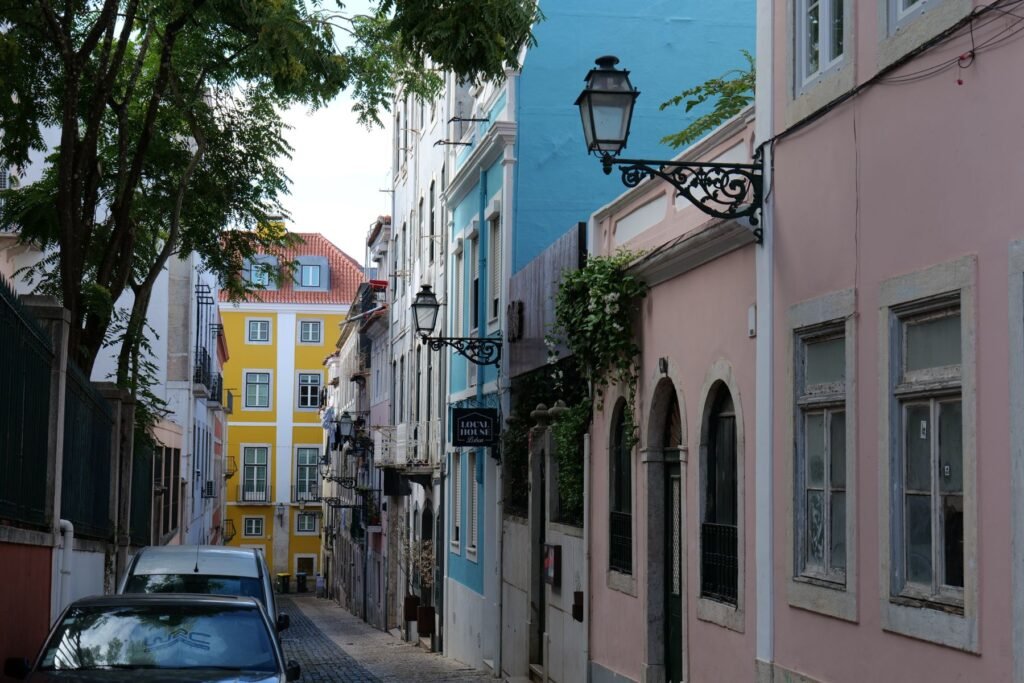
Understanding Lisbon’s Culture
One of the reasons Lisbon feels so great as a solo female traveller is its culture.
Portuguese locals tend to be relaxed, friendly and warm, but not in a way that feels overbearing or persistent.
You’ll also notice that the pace moves a little slower here, even though Lisbon is Portugal’s capital city. Meals last longer. Strangers smile but don’t usually intrude. It’s a very comforting (and comfortable) atmosphere to be a part of.
And what’s also helpful to know is that Lisbon isn’t a 24/7 party city.
Yes, there is of course nightlife (and I’ll get to that in just a bit!), but most locals go out for dinner around 8 or 9pm, not 11pm. So this means the streets in central areas are busy until late, but not chaotic or overwhelming like in other cities.
Plus, Portugal as a whole is also very popular with solo female travellers, so it’s not uncommon to see women walking alone, even at night.
And if you’re sitting alone at a restaurant? No one will bat an eye. Solo female travel is definitely not a novelty in Lisbon!
Katie’s Top Tip: One of the easiest ways to embrace Lisbon’s pace is to spend time at a miradouro (which means viewpoint). Grab a coffee (or pastel de nata!), enjoy the view and people-watch for a while. It’s the perfect slow travel moment! You’ll find these miradouro’s all over the city, but my favourite in Lisbon is Miradouro de Santa Catarina.
Attitudes Towards Women in Lisbon
Let’s be honest, one of the most quietly stressful parts of solo travel as a woman is not knowing how you’ll be perceived by local people and cultures.
So the good news is that Lisbon has a very respectful and relatively modern attitude towards women. And like I said, solo female travellers are very common in the city.
During my trips to Lisbon, I’ve found that local people generally mind their own business.
And I’ve also found that you’re unlikely to be stared at or approached during the day, just because you’re a woman travelling alone.
In my experience, almost all of my interactions with locals (whether they’re tour guides, taxi drivers, shopkeepers, servers or people on the street), have been kind and professional.
But of course, like any city, Lisbon sadly isn’t immune to street harassment.
Especially in more tourist-heavy areas, you might get the odd comment or unsolicited attention. (From my point of view, I wouldn’t say it’s constant or threatening, but it does happen, so it’s important to go in aware).
Katie’s Top Tip: A confident walk and a firm “no” will shut down most unwanted attention quickly. Portuguese culture tends to respect direct boundaries, so don’t be afraid to set them.
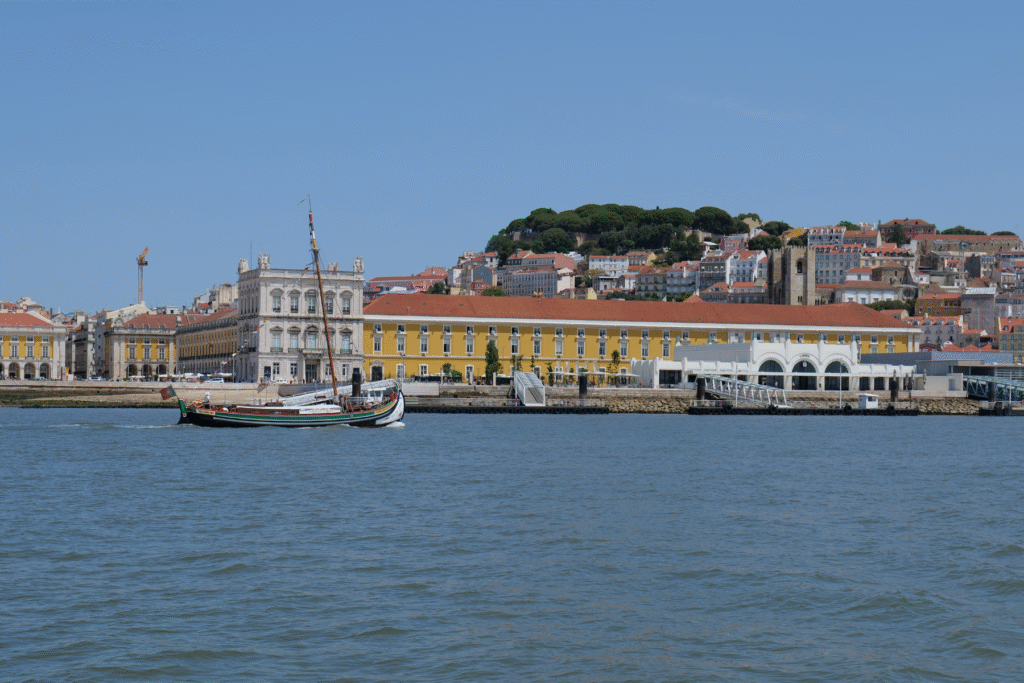
How to Dress in Lisbon
Lisbon is a stylish city, but it’s also not flashy.
Locals in Lisbon tend to go for neat, dressy casual looks. (Think neutral colours, good shoes and a polished but effortless vibe, and you can’t go too far wrong!)
Don’t get me wrong though, you definitely don’t need to dress up (and your heels are best left at home – did I mention the hills?!), but wandering around in beachy-European clothing will make you stand out, in my experience.
If you’re walking around touristy areas, you’ll see plenty of variation to this, but from my point of view, blending in with the locals goes a long way to saying how comfortable I’ll feel.
And when it comes to how to dress in Lisbon, comfort matters too. Just as much.
Lisbon’s streets are famously hilly, with pavements covered in slippery cobblestones, so as I said: leave those heels at home!
During my first solo trip to Lisbon, I made the mistake of wearing flat-soled, fairly cheap sandals and definitely paid the price with blisters and a broken strap on my first day! (Which I then Sellotaped back together. Fashionable, I know!)
So don’t be like baby, inexperienced Katie, and pack your comfiest trainers. You can thank me later!
Katie’s Top Tip: For my trips I now pack my unofficial Lisbon “uniform”: white trainers, a crossbody bag that zips, a light jacket for layering (regardless of season), a light scarf, midi dresses, wide-leg trousers, and linen everything! It’s served me well over the years!
Lisbon Crime Rates
Let’s look at the numbers for a sec, because while feelings and vibe are arguably most important, the numbers and stats definitely matter too.
Like I said earlier, according to the most recent Global Peace Index data, Portugal consistently ranks as one of the safest countries in the world (currently sitting at number 7).
And Lisbon, even though it’s a capital city, is no exception to that.
According to Numbeo’s data, Lisbon scores low on most crime indicators, especially when compared with other capital cities in Europe.
The overall crime level, violent crimes, theft and muggings all considered to be low risk (especially for tourists). And worries about being attacked due to gender, race or religion are also very low in Lisbon, which is reassuring for solo female travellers.
Crimes you are more likely to encounter in Lisbon are pickpocketing, petty theft and tourist scams. And landmarks like Tram 28, Rossio Square and the Santa Justa Lift are known hotspots for this kind of petty crime.
But, even pickpocketing and tourist scams in Lisbon are much fewer than other popular tourist cities in Europe. (I’m looking at you, Paris!)
Katie’s Top Tip: In Lisbon, like anywhere, there are areas where the vibe changes after dark. Areas like Intendente, Martim Moniz and Anjos have higher crime reports, often linked to drug activity or muggings, and especially at night. That doesn’t mean you can’t go there, especially during the day, but you should be extra aware.
Risk of Theft in Lisbon
Before we get to talking about theft, I want you to know that Lisbon is not a dangerous city, and it is definitely not the worst in Europe for theft.
But it does happen – and it’s usually the sneaky, grab-and-go kind.
So I’m talking things like bag snatching in busy streets, pickpocketing on crowded trams, purses taken from jacket pockets in cafés, or phones snatched from an outdoor restaurant table.
If you look even a little lost or distracted (and let’s be honest here, we all do sometimes), you’re a higher target for opportunistic theft, especially in tourist-heavy areas like Rossio Square or on Tram 28.
As an example, I once had a guy try the old “you dropped something!” scam, where I was sitting by the waterfront. While I glanced down to have a look, his friend made a move towards my bag. Luckily, I’d seen that trick in Paris before and caught on before he could get too close. I stood immediately, said a very firm “no” and walked away quickly and confidently (even though I definitely wasn’t feeling confident!)
This situation reminded me that Lisbon, for all its beauty and encouraging safety stats, isn’t immune to this stuff.
In terms of stats, in 2023, the Greater Lisbon area recorded 44,866 crimes against property (including theft, burglary, robbery and pickpocketing), which was by far the most commonly reported crime, according to Statista.
And while that number might seem high, it’s definitely worth noting here that Lisbon is a major capital with millions of visitors a year and so, in context, these rates are still low.
So don’t get me wrong: please don’t walk around paranoid, or you’ll never enjoy your trip.
Instead, it’s about knowing what to stay aware of ahead of time, so you can stay one step ahead of these petty criminals, like I did. (I’ll cover more of the specifics of this in the scams section in just a bit!)
Katie’s Top Tip: Never hang your bag on the back of your chair or keep your phone on the table at outdoor cafés or restaurants, even if everyone else is doing it. Instead, keep it zipped and in your lap, attached to your body or looped around your chair leg. It’s an easy habit that makes you a much harder target.
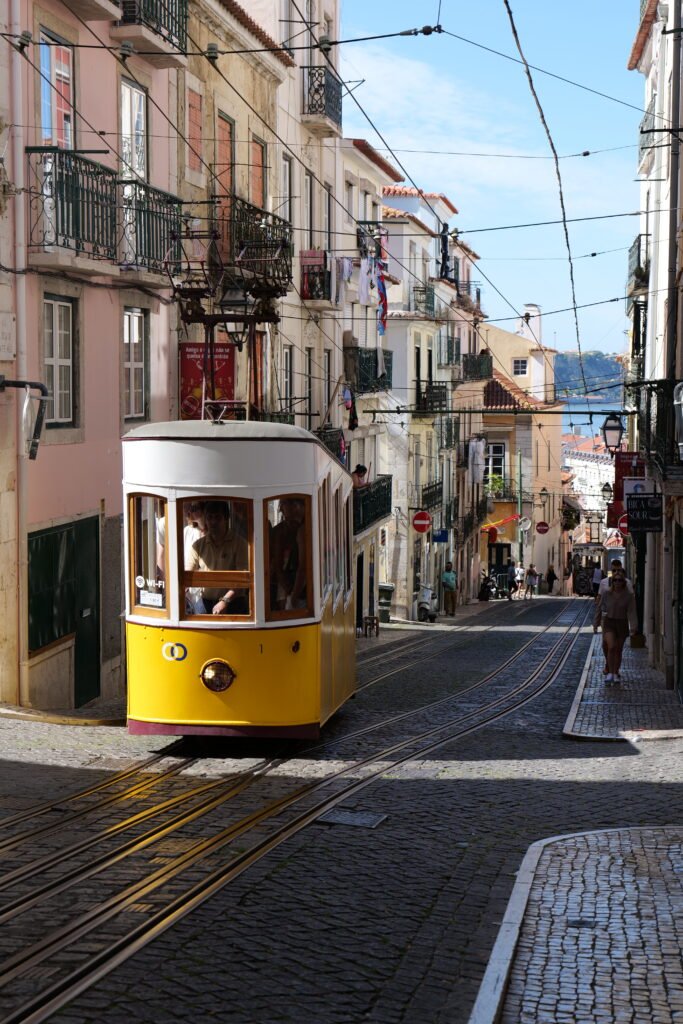
Risk of Terrorism in Lisbon
This one’s tough to talk about because terrorism feels like the scariest thing on this list, but it’s also the most unpredictable.
Here are the current facts: Portugal’s terror threat is at “significant” and the UK government, for example, say that an attack “cannot be ruled out.”
But in these unstable times we’re living through, that’s sadly the way it is in almost every country in the world, not just Europe.
Portugal in general hasn’t experienced the same level of high-profile attacks as other Western European countries, and it doesn’t have the same political tensions that make other cities more vulnerable.
Don’t get me wrong, it’s not immune (nowhere is), but I’ve personally never felt that sense of unease that some other big cities give you.
So bottom line: please don’t let this be the thing that puts you off visiting Lisbon.
Katie’s Top Tip: Stay aware (but not paranoid) of your surroundings in crowded places or during major public events. And also listen out for info regarding current affairs (especially protests or political demonstrations), and avoid the area if they are taking place.
Risk of Violent Crime in Lisbon
When we talk about crime that really scares solo female travellers, like violent attacks, muggings and assaults, Lisbon scores well.
Violent crime is very rare, especially against tourists.
Again, it’s not zero (because nowhere is), but it’s far less common than in popular cities like Paris, London or Rome.
I’ve walked home alone at night in Lisbon many times and, apart from the occasional too-empty side street, I never felt unsafe.
But it’s still worth knowing your surroundings.
Places like Intendente, Martim Moniz, Anjos and the quieter side streets of Cais do Sodre, Alfama and Graca can feel isolated and a little sketchy after dark. (Not necessarily because something bad will definitely happen, but because they’re less populated and poorly lit).
There have also been reports of muggings after dark in all of those locations, especially near the metro stations or on dark side streets, so it’s best to avoid them all-together at night.
To do this, either walk home via a different route, get back to your accommodation before it gets dark (easier done in summer, I know!), or call a taxi.
Oh and most importantly? Trust yourself.
If something feels off, change your route, call a taxi, or pop into a restaurant or hotel to get help. You’re not overreacting.
If your gut is telling you something is off, it probably is – and you should listen.
Katie’s Top Tip: Carry a personal alarm, which will make an ear-splitting loud noise if you pull the pin out. I clip mine to the inside of my bag. I’ve, (touch wood!), never had to use it – but it’s reassuring to know it’s there.
Risk of Harassment in Lisbon
Street harassment in Lisbon does exist, but it’s usually mild and manageable (although never okay or acceptable).
Think the occasional catcall, awkward stare or that “hey beautiful” (or the Portuguese alternative to that, I guess!) kind of nonsense rather than anything physically aggressive.
And harassment in Lisbon tends to happen more in nightlife areas after sunset when a few too many drinks are involved, rather than in broad daylight or busy areas.
I’ve had a few uncomfortable moments in Lisbon, but nothing that made me feel unsafe (just irritated, to be honest!)
What helped me most was realising that most of this attention isn’t personal. It’s just lazy and opportunistic and desperate. And the kind of people who do it will usually back off fast if you ignore them, say a firm “no” or give them a firm look and walk away.
Katie’s Top Tip: Having one earbud in (or both if you have transparency mode enabled), is a great trick if you’re tired of unwanted comments. They send a clear “not today, back off” message, without you having to say a word.
Risk of Pickpocketing in Lisbon
Pickpocketing deserves its own section because, unfortunately, it’s the number one risk to tourist safety in Lisbon.
Pickpocketing is annoyingly common, especially in places you’re meant to love as a tourist: busy viewpoints, historic tram rides, crowded escalators, metro lines…
These aren’t typically dramatic grab-and-run crimes that you might see in the movies, either.
Instead they’re fast, practiced and so smooth you might not even realise it happened until hours later when you reach for your purse and discover it gone.
Again, I’m not trying to scare you. But it is important to have that knowledge so that you can take precautions to protect yourself and your belongings.
Tram 28 is famous for this – and not in a cute way! Pickpockets work in teams, often posing as fellow tourists. They also use common distraction techniques like “you dropped something” or even just brushing up against you or jostling you as you get on or off.
You’ll also want to be extra aware around the Rossio Square, Time Out Market and in Belem.
These are all beautiful things to do in Lisbon, and you absolutely should visit them all, but they’re also pickpocketing hotspots. (Places where pickpockets know we let our guard down). So remember to keep your level of awareness up in these areas.
Katie’s Top Tip: Ditch the open tote and rucksack and switch to a sturdy crossbody bag that zips fully (inside and out) and sits across the front of your body. It’s not just a nice-to-have or an optional extra in Lisbon, instead it could potentially save you a whole lot of stress and upset.
Risk of Scams in Lisbon
Let’s talk scams now. Because honestly, this is one of the few areas where Lisbon doesn’t get a good report for safety. So while violent crime is rare, tourist scams are definitely a thing here.
They’re not usually aggressive, but they are clever, and if you’re tired, distracted or on your phone, they can catch you off guard fast.
Here are the most common tourist scams in Lisbon:
- Distraction techniques (like “you dropped something!”), are common. And scammers will work in pairs to distract and pickpocket you. Staying vigilant and wearing a crossbody bag will help you avoid this one.
- The most common scam I’ve seen is the friendship bracelet scam. Someone (usually very friendly) will approach you and try to tie a bracelet around your wrist (or “give” you something), before demanding money. Bottom line, if someone approaches you or offers something you didn’t ask for, walk away.
- The clipboard/petition scam is another similar one, where someone will approach you, ask for a quick signature “for charity,” potentially getting your personal information or hassling you for a donation. Again, just walk away.
- Being given “free” bread or olives (that you didn’t ask for) in a restaurant and then being charged for them at the end. It is totally okay to refuse them or ask explicitly if it is complimentary before you accept.
- Taxi scams like not putting the meter on, over-inflated fares for tourists from unlicensed drivers, or adding a random luggage surcharge. To avoid this, make sure you only pick a reputable company. And if a driver is touting strangers for rides (typically at transport hubs)? Avoid, avoid, avoid!
- There have also been reports of drug sellers approaching people in the street to try to get them to buy, often fake, drugs. They can be quite persistent, so say no firmly and walk away with confidence. And if they won’t leave you alone, don’t be afraid to make a scene.
But the good news is that, once you know these tricks, they’re surprisingly easy to spot and sidestep, like I did when that guy came up to me with that classic distraction technique.
And if you walk with confidence and stay aware, most scammers will just move on to easier targets anyway.
Katie’s Top Tip: If someone tries to hand you something (whether it’s a rose, a bracelet, a flyer), don’t take it. Just shake your head, say a firm “no” and keep walking.
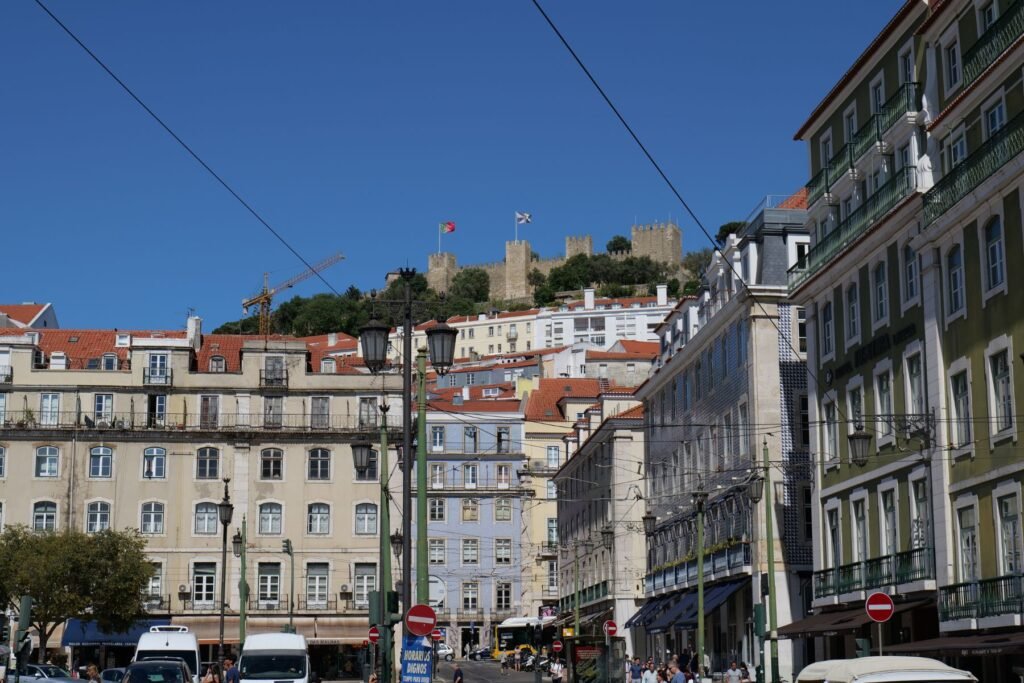
Lisbon Emergency Number
Portugal’s national emergency number is 112 (which is also the emergency number for the whole of Europe, FYI), and it works across the country for police, ambulance and fire services.
You don’t need a local SIM or even phone service to call it, and operators speak English.
Katie’s Top Tip: Screenshot your accommodation address and keep it in your phone gallery, and save 112 to your contacts. If you’re stressed, lost or you lose mobile data, you’ll be so glad to have it on hand in the event of an emergency.
The Safest Places to Visit in Lisbon
If you’re planning your trip to Lisbon and wondering where you’ll feel most comfortable exploring solo, the truth is: most of Lisbon feels very safe during the day and at night.
But some areas stand out for being especially great for solo female travellers – walkable, beautiful, bustling with both tourists and locals…
Alfama has a calm, neighbourly feel (especially during the day) and some truly stunning viewpoints. Plus the neighbourhood is home to some of Lisbon’s top tourist attractions, so there are always both tourists and locals around.
Chiado is more polished and full of cafés, galleries and independent shops, making it perfect for a more relaxed day of exploring.
Principe Real is another personal favourite Lisbon neighbourhood of mine – leafy, upscale and less touristy, with gorgeous boutiques and a safe, lived-in vibe.
And Belem, too, outside of Lisbon city centre, is ideal for a solo day or half day trip, with a wide promenade, a quieter atmosphere, beautiful views, and a fascinating history to learn about. Jeronimos Monastery is a must-see here!
Even Bairro Alto, known for its nightlife, bars, restaurants and fado music, feels very relaxed and comfortable to explore as a solo female traveller in Lisbon, especially during the day.
Katie’s Top Tip: I always save key spots I want to visit in Google Maps ahead of time. Then if I wander off-plan (which always happens!), I still feel like I can get back to my plan at any point because I’m already prepared, without having to pull my phone out constantly, looking distracted.

Places to Avoid in Lisbon
No city is perfect and Lisbon has a few areas that are best avoided, especially after dark.
(To be clear, these aren’t 100% “dangerous” areas, but they can feel sketchy, especially if you don’t know your way around).
Top of the list, as I’ve mentioned several times, is Intendente, Martim Moniz and Anjos.
In these neighbourhoods, there have been reports of muggings (especially in quieter backstreets or around the metro stations after dark), and you’re also more likely to witness open drug use or harassment here. The Intendente metro station is the most commonly reported location for this.
I’ve walked through some of these neighbourhoods in the daytime and been fine. But at night? I don’t book accommodation in these areas and if I’m walking anywhere near the area after dark, I reroute immediately or grab a taxi. It’s just not worth the risk.
Cais do Sodre and Bairro Alto can also feel uncomfortable late at night, because of the nightlife in these areas. Walking through these neighbourhoods at night, you’ll likely meet people who have been drinking heavily or pushy bar/club promoters trying to get you through the door. Petty crime is also more common here.
But as I keep saying, this doesn’t mean you have to avoid these areas entirely.
Just be aware of your personal comfort tolerance levels (e.g. do you like the nightlife vibe, or does it make you feel uncomfortable?), the time of day, trust your gut instincts and don’t be afraid to change your plans if something feels off.
Katie’s Top Tip: If you arrive somewhere and it feels wrong, even if it’s on your itinerary, leave. There’s no shame in skipping a spot. Your peace of mind and safety are way more important than ticking every box on your list of things to do in Lisbon.
Is Lisbon Safe at Night?
This is one of the most common questions I get about solo travel safety in Lisbon, and I get it.
Walking alone at night in a new city, especially as a woman, will make you feel like you’re suddenly hyper-aware of every shadow and footsteps around you.
But know this: Lisbon is generally safe at night.
And the stats back this up too, with Numbeo reporting that safety walking alone in Lisbon at night scores high, which puts Lisbon well ahead of many other popular European cities.
You just need to be smart about where and how you navigate the city.
For example, main streets in Baixa, Alfama, Chiado and Principe Real stay fairly busy into the evening, especially near restaurants, as locals tend to eat out later in Portugal.
In all of these areas, I’ve walked home from dinner or an evening walk without ever feeling uncomfortable or unsafe.
But the quieter side streets (especially those beautiful, but now likely empty side streets in Alfama or backstreets near Rossio Square), will feel totally deserted and isolated after around 10pm.
So if you’re planning a night out or want to catch a late sunset at Miradouro de Santa Catarina, that’s totally doable. Just plan your route home ahead of time and stick to busy main roads.
Seriously, never take that isolated shortcut – even if it does save you a couple of minutes’ of walking time. You’ll feel so much more comfortable where other people are around.
Katie’s Top Tip: Download the route home and take a photo of the outside of your accommodation before heading out at night. Street names can be tricky to find in the dark and buildings often look similar, so it’s always good to have a backup plan. Or, if in doubt, call for a taxi instead of walking.
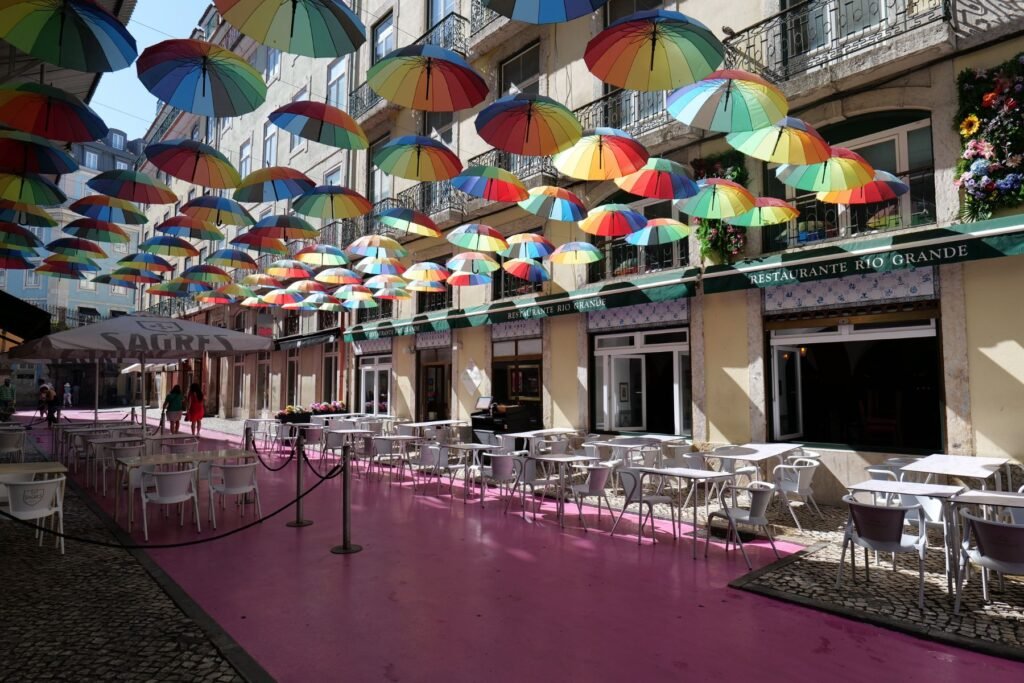
Nightlife in Lisbon
So you want to know if it’s actually safe to go out at night in Lisbon by yourself, maybe to catch a fado show, enjoy a sunset cocktail, or enjoy the nightlife at a bar or nightclub.
And the short answer is: yes, it is safe – but, like always, there are a few caveats.
Lisbon’s nightlife is vibrant and varied, and as a solo female traveller, you can join in without feeling like the odd one out. Like I said before, Portugal’s capital is very popular among solo female travellers, so you won’t be alone in being alone!
The best areas for nights out are Cais do Sodre (especially along Pink Street), Bairro Alto, and Alfama for traditional fado. Bairro Alto is the most casual. Cais do Sodre feels more clubby. And Alfama is your go-to for live fado music and a more touristy experience.
As always, just know your limits: the drinking culture can be strong here and peer pressure is a big thing. But know that it’s totally okay to call it a night early or take a taxi home if you feel uncomfy.
Don’t forget, trust your gut if something feels off.
Katie’s Top Tip: If you’re heading out solo, stick to smaller venues with seated areas and live music, like fado bars, instead of high-energy clubs. You’ll still get to experience Lisbon’s nightlife, but in a way that feels way more relaxed!
Safest Time of Year to Visit Lisbon
From a safety POV, there’s no wrong time to visit Lisbon, but in my experience, a few months stand out as particularly good for solo female travellers.
If you’re hoping for still bustling streets, milder weather (aka not scorching hot!) and a good number of daylight hours for exploring, aim for late April to early June or mid-September to late October.
These shoulder seasons give you the best of both worlds: fewer tourists than in peak summer, but still enough buzz to feel safe walking around. The weather is warm but not unbearably hot. And there are still tons of local events to enjoy.
Summer in Lisbon (late June to August) is fine too, but that intense heat will make everything feel more intense, and petty theft spikes when the crowds reach their peak.
Lisbon’s streets and attractions are all crazy busy in summer too and really, this season is for beach days – not a city break!
Winter in Lisbon is quieter but still safe and totally doable. Just be aware that some areas will feel a bit too empty, especially after dark, as people are less likely to be out exploring in this season.
Katie’s Top Tip: If safety and non-scorching temperatures (but still warm!) are your top priorities, go for May or late September. You’ll get a beautiful light for photos, fewer queues at major attractions, and streets that still feel buzzy and alive without being chaotic or rammed with tourists.
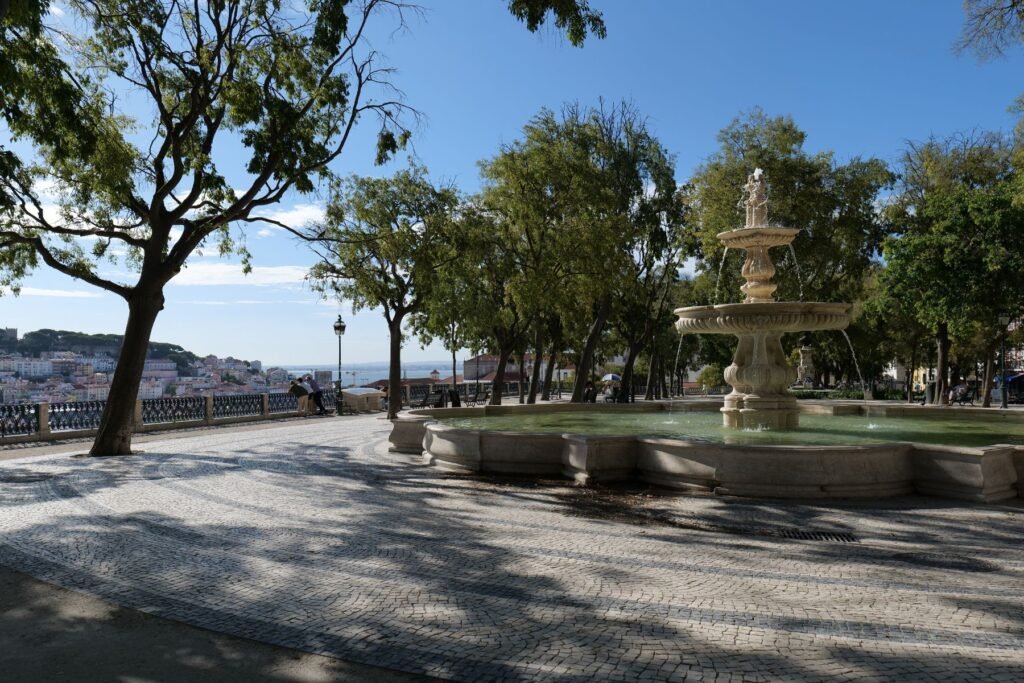
Is English Spoken in Lisbon?
The English level in Lisbon is really good!
In touristy areas, cafes, restaurants, hotels and even metro stations, it’s completely normal to hear English spoken fluently, especially from younger locals and those who work in hospitality.
Plus, as a capital city, Lisbon is very international and diverse anyway.
However, a little effort with the local language goes a long way in Portugal. Saying “obrigada” (thank you) or “bom dia” (good day) shows respect, and locals genuinely appreciate it.
Katie’s Top Tip: Add key Portuguese phrases to your Notes app before you travel and also download the Portuguese language pack on Google Translate so you can use it offline. The photo translate feature is my best hack for translating menus/signs/etc.
Is Public Transport Safe and Reliable in Lisbon?
Public transport in Lisbon is one of the easiest (and safest) ways to get around, especially as a solo female traveller.
You don’t need a car in Lisbon, and I’d actually recommend against it. Parking is expensive and driving the busy city streets is a nightmare!
The metro is clean, efficient, affordable and relatively safe during the day – although you should stay alert if using the metro or walking around the metro stations at night.
But not all lines of the metro are created for tourists. So you’ll feel more comfortable sticking to the more “touristy” lines. (They’re probably the only ones you’ll need to use, anyway).
- The red metro line to the airport is well-lit, modern and there are almost always other tourists and locals about so you won’t feel isolated.
- The blue and green metro lines cover most of the tourist hotspots.
- You shouldn’t need to use the yellow line.
Also try to avoid taking the last metro of the night, just because the stations get a lot emptier and isolated at this time.
The trams are charming and again efficient and relatively affordable, but they are also popular with tourists and get very busy, so they are therefore more prone to pickpockets.
Just remember to always keep an eye on your belongings on Tram 28, especially during peak tourist hours.
But overall, Lisbon’s public transport is way safer and much more straightforward than many other European capitals.
Katie’s Top Tip: Lisbon is very walkable, especially if you plan your itinerary by area (aka grouping attractions in similar locations together). So try to limit your use of public transport where you can – it’s more affordable and a much better way to see the very best of the city!

Top Solo Female Travel Safety Tips for Lisbon
Okay, so if you’re still wondering: is Lisbon safe for solo female travellers? Let me give you some of my very best Lisbon safety tips to make sure it is:
- Stick to well-lit, busy streets after dark. Avoid walking down narrow alleys or quiet shortcuts at night, even if they do seem faster on Google Maps.
- Wear a crossbody bag that zips. Lisbon has a reputation for pickpocketing on trams, on the elevators, and on busy streets, so keep your bag in front of you and avoid open totes or rucksacks.
- Be cautious on Tram 28. Ride it early in the day, avoid peak time and always keep your hand on your belongings. The tram is iconic, yes, but also a prime hotspot for petty theft.
- Don’t feel rude saying no. If someone approaches you with a bracelet, clipboard or unwanted small talk, just walk away. Scammers and street sellers will always target distracted or unsure tourists, so confidence (whether it’s fake or real), is your greatest safety tool.
- Limit alcohol and know your limits. Lisbon’s nightlife is fun and generally safe for solo female travellers, but keep your drink in sight at all times, don’t accept anything from strangers and trust your gut. The same as anywhere!
- Carry a fully charged phone and portable charger. I don’t think I need to explain this one – we use our phones for everything on the road: navigation, connection, tickets, safety… So having a working phone (and backup power on the go) will help you feel more in control.
So, Is Lisbon Safe for Solo Female Travellers?
Yes! Lisbon is absolutely safe for solo female travellers.
It’s definitely not perfect (let’s be real, no city or place is), but it’s one of those rare capital cities where you can walk alone, explore at your own pace and also slow down and take your time.
The locals are generally warm and friendly, the public transport system is reliable and (mostly) safe with the right precautions, and the vibe is a perfect mix of laid-back and buzzy.
But, as I hope you know by now, solo female travel safety is about so much more than stats or fear-mongering, clickbait headlines.
Solo female travel safety is instead mostly about how you feel in a place.
So that means trusting your gut, making a few smart choices, knowing (and using) some key solo travel safety habits, and giving yourself permission to adjust your plans if something feels off.
But the bottom line is that you don’t have to be fearless or unafraid to travel solo. (Trust me, I’m still scared and anxious before every single one of my solo trips, even though I’ve been doing this for years!)
Instead, you just have to be ready to embrace the city or country you’re visiting, stay aware (but not paranoid), of your surroundings and, most importantly, be kind to yourself.
And I can’t think of a better capital city to start with than Lisbon!
Read More About Travel in Portugal:
- Is Porto Safe For Solo Female Travellers? Porto Safety Tips
- How to Spend 3 Days in Porto: Your Perfect Porto Itinerary
- The 7 Best Day Trips From Porto (No Car Needed!)
- 17 Best Things To Do Alone in Lisbon For Solo Travellers
- 11 Best Day Trips from Lisbon You’ll Wish You Knew Sooner
Grab Your Solo Female Travel in Europe Starter Kit:
Pin Me For Later!
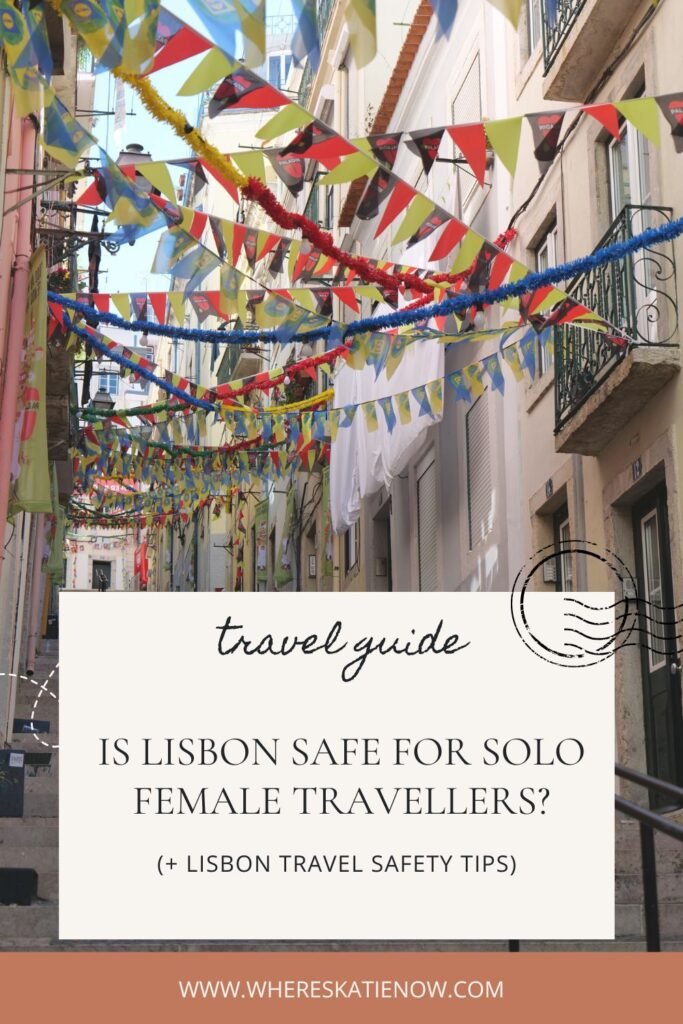
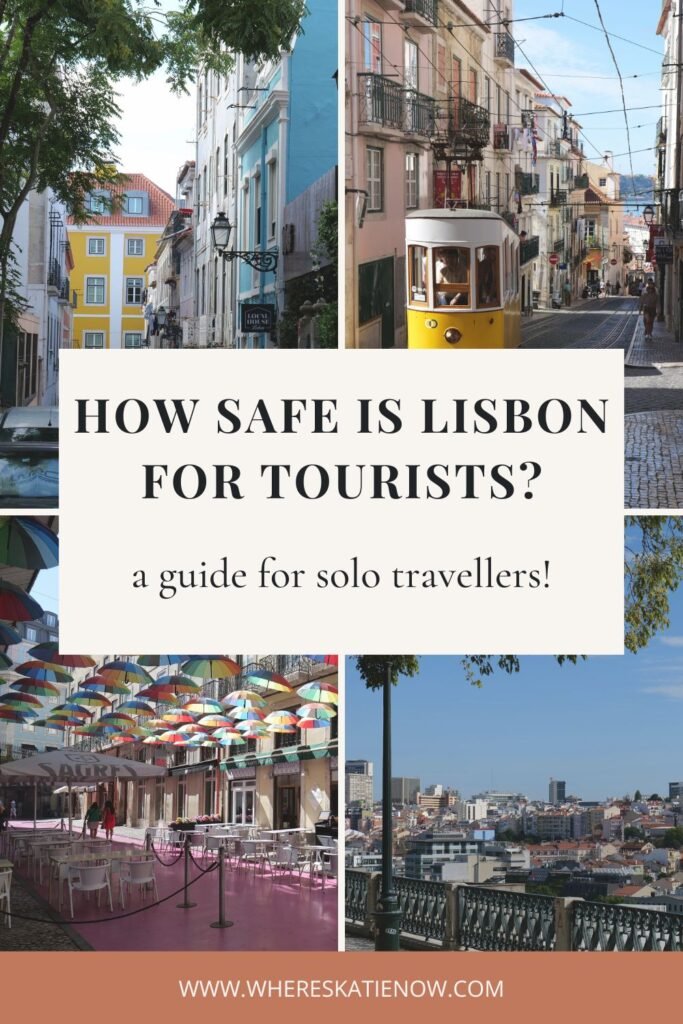
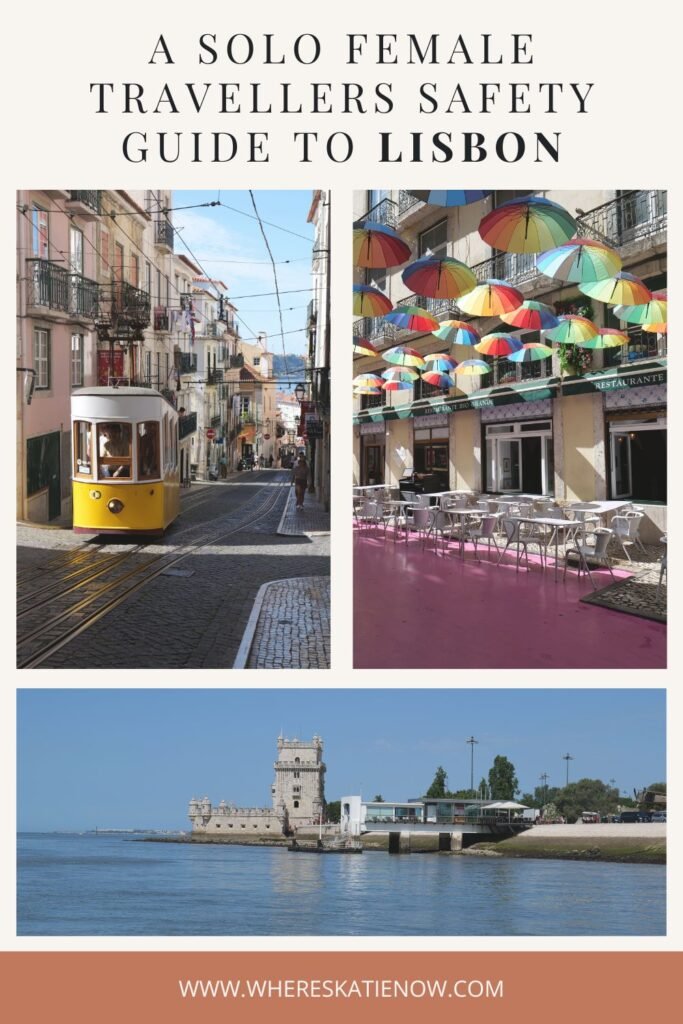

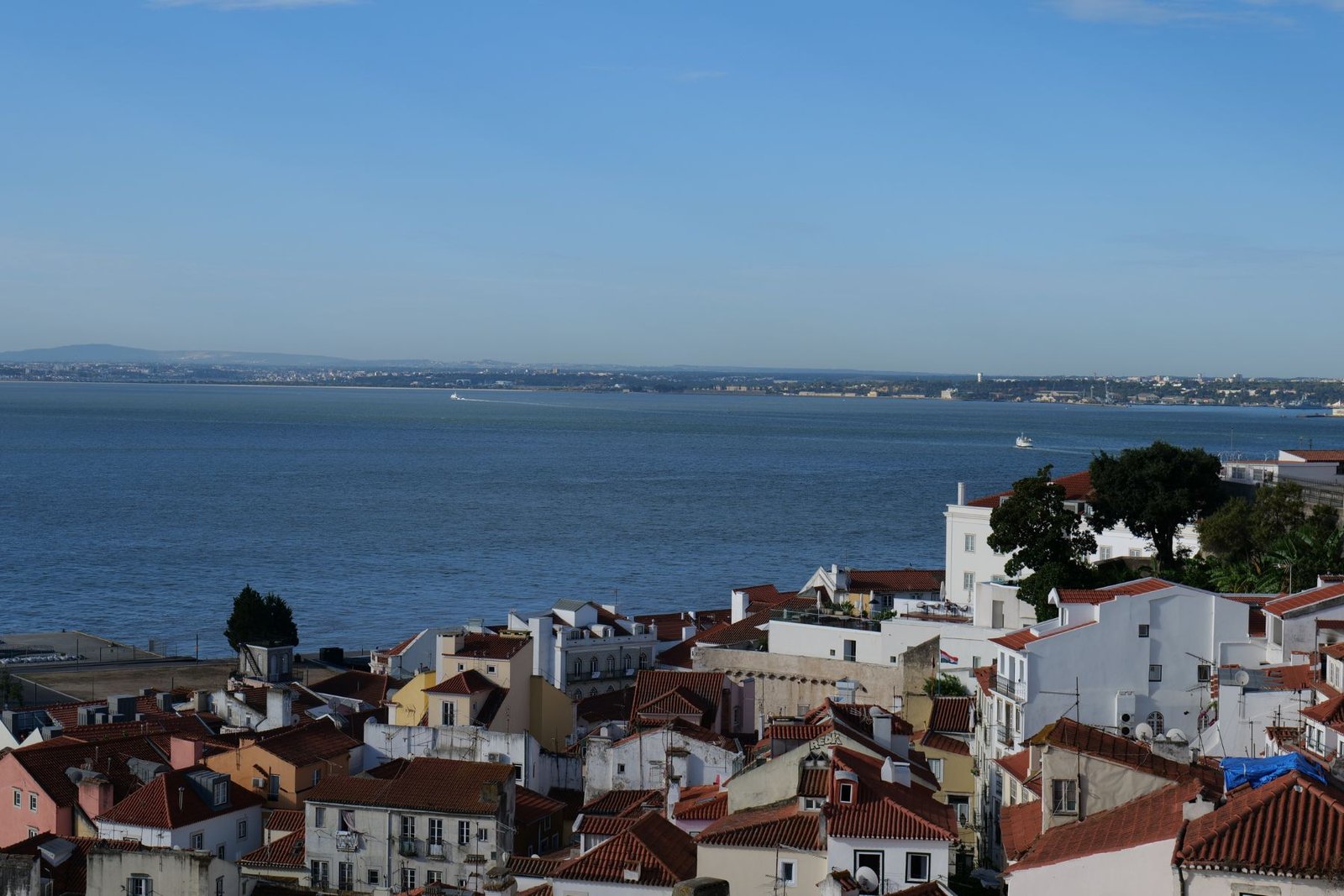
2 Comments